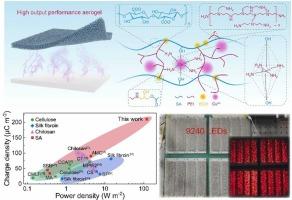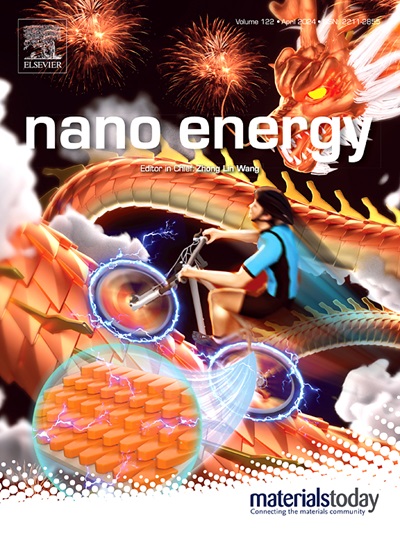胺修饰和金属离子配位制备海藻酸盐基生物摩擦正膜以获得高表面电荷密度
IF 16.8
1区 材料科学
Q1 CHEMISTRY, PHYSICAL
引用次数: 0
摘要
开发高电荷密度的摩擦电材料是促进摩擦电纳米发电机(TENG)大规模应用的关键。然而,大多数报道的作品只对摩擦负极材料感兴趣,而很少涉及摩擦正极材料。本文提出了一种通过接枝聚乙烯亚胺(PEI)和络合铜离子来提高海藻酸钠(SA)基摩擦正膜电荷密度的有效方法。制备的SA/PEI-Cu (SP-Cu)气凝胶膜不仅具有优异的柔韧性和良好的环境相容性,而且具有较高的输出摩擦电性能。在尺寸为5×5 cm2的气凝胶薄膜上,制备的TENG具有3.5 kV的高输出电压、120 W m-2的最大峰值功率密度和205 μC m-2的显著输出电荷密度,是纯SA的近8.2倍,打破了所有生物质能摩擦材料在环境条件下的记录。使用这个小型TENG装置可以点亮9000多个led和一个24w的荧光灯。特别是,我们成功地制造了一个带有电源管理模块(PMM)的旋转TENG设备,用于收集风能,为智能农业的无线环境传感系统供电。本研究为高性能生物摩擦正材料的开发提供了一种新的策略,可能促进TENGs的实际应用。本文章由计算机程序翻译,如有差异,请以英文原文为准。

Fabrication of alginate-based bio-tribopositive films via amine modification and metal ion coordination for high surface charge density
Developing triboelectric materials with high charge density is crucial for promoting large-scale applications of triboelectric nanogenerators (TENG). However, most of the reported works are only interested in tribonegative materials, while the tribopositive materials are rarely touched. Here, an efficient method was proposed to significantly boost the charge density of sodium alginate (SA)-based tribopositive films by simply grafting polyethyleneimine (PEI) and complexing copper ions. The prepared SA/PEI-Cu (SP-Cu) aerogel films not only have excellent flexibility and good environmental compatibility, but also high output triboelectric performance. Based on the aerogel film with a size of 5×5 cm2, the fabricated TENG reveals a high output voltage of 3.5 kV, a maximum peak power density of 120 W m-2, and a remarkable output charge density of 205 μC m-2, which is nearly 8.2 times high that of pure SA and breaks the record for all reported biomass tribo-materials under environmental conditions. More than 9000 LEDs and a 24 W fluorescent lamp can be illuminated using this small-size TENG device. In particular, we successfully fabricated a rotating TENG device with a power management module (PMM) for harvesting wind energy to power a wireless environmental sensing system for smart agriculture. This work provides a novel strategy for developing high-performance bio-tribopositive materials, which may promote the practical applications of TENGs.
求助全文
通过发布文献求助,成功后即可免费获取论文全文。
去求助
来源期刊

Nano Energy
CHEMISTRY, PHYSICAL-NANOSCIENCE & NANOTECHNOLOGY
CiteScore
30.30
自引率
7.40%
发文量
1207
审稿时长
23 days
期刊介绍:
Nano Energy is a multidisciplinary, rapid-publication forum of original peer-reviewed contributions on the science and engineering of nanomaterials and nanodevices used in all forms of energy harvesting, conversion, storage, utilization and policy. Through its mixture of articles, reviews, communications, research news, and information on key developments, Nano Energy provides a comprehensive coverage of this exciting and dynamic field which joins nanoscience and nanotechnology with energy science. The journal is relevant to all those who are interested in nanomaterials solutions to the energy problem.
Nano Energy publishes original experimental and theoretical research on all aspects of energy-related research which utilizes nanomaterials and nanotechnology. Manuscripts of four types are considered: review articles which inform readers of the latest research and advances in energy science; rapid communications which feature exciting research breakthroughs in the field; full-length articles which report comprehensive research developments; and news and opinions which comment on topical issues or express views on the developments in related fields.
 求助内容:
求助内容: 应助结果提醒方式:
应助结果提醒方式:


